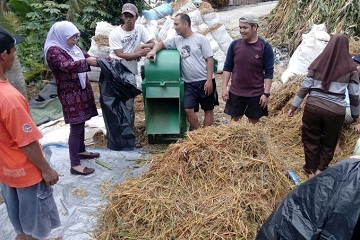IPB Researchers Utilizing Complete Ration of silage to Improve the Productivity of Dairy Cows

Dairy cows are the largest dairy cattle in Indonesia. Great efforts are required to increase the population, productivity and persistence of dairy cattle so that milk imports can be suppressed and self-sufficiency target of 50 percent milk by 2020 can be achieved. Many factors can affect the productivity of cow's milk, such as the availability of sustainable feed both concentrates and high quality forage. High quality feed can be produced from fermentation of sugar-rich feed. Fermentation is an environmentally friendly method to improve feed quality.
Accordingly, a team of animal husbandry researchers from the Department of Animal Nutrition and Feed Technology (INTP) of Faculty of Animal Husbandry of Bogor Agricultural University (FAPET IPB), consisting of Despal, Idat Galih Permana, and Dwiera Evvyernie Amirroenas implemented experimental program to improve dairy cattle productivity and competitiveness of farmers utilizing complete ratio of silage-making technology on cattle feed. This program is implemented in di Kawasan Usaha Peternakan Sapi (Kunak Dairy Farm areas) Cibungbulang, Bogor.
Fodder conservation has the main objective of ensuring feed availability during periods of scarce feed supply. The silage-making technique is a forage preservation through anaerobic lactic acid fermentation. The silage-making technique allows preserving the forages in the rainy season, harvesting forage at the highest productivity, resulting in increased production per hectare, generating large forages (transport efficiency) and preserving large quantities of agricultural waste available for use when forages are difficult to obtain.
One of the areas of critical concern world-wide is how to meet the food demands for a growing world population while farmland acres continue to shrink, this affect grass pasture areas to produce the raw materials of silage declined. The process of making silage involves fermentation under anaerobic conditions. It prevents fresh fodder from decomposing and allows it to keep its nutrient quality. The silage making program contributes to economic development of the livestock industry by enabling greater use of local feed resources through conservation. This is particularly so with regard to fresh/wet crop residues and agro-industrial by-products which otherwise will be wasted. Silage is not only possible but also practical to maintain all the year round supply of quality roughages for milch and drought animals. so inevitably there must be conservation efforts meaning preservation of forage to be available all the time. Fodder conserved in a season of plenty is an insurance against under feeding and economic losses during scarcity period. Conserved forage is not only forage produced in the rainy season, but also treating some wastes seasonal crops such as rice straw. Rice straw as forages can be made into hay to conserve the nutrients, especially protein, before they decline in the plant, "said Despal.
The study uses participatory approach which is divided into three phases, namely inception, implementation and monitoring and evaluation. Partners for this cooperative study were two dairy farmers, they are members of Bogor's Koperasi Peternakan Sapi (KPS Animal Husbandry Cooperative) located in Kunak Cibungbulang. Those dairy farms raise, lactation cattle as many as 12 and 15 cows. The results of inception stage carried out by the team revealed the description of daily program of breeders, cooperative management agreement, and feeders supplying program. Change or adjustment of the type of raw materials used for silage is also must be decided in the inception phase, based on the available feed availability and the livestock preferences.
Complete ration silage is a silage composed of several kinds of feed ingredients that have been formulated. In the manufacture of complete feed-shaped silage is similar to the process of fermentation in general. The mixture of forage raw materials cut into pieces with chopper machine then mixed and stirred evenly with the concentrate ingredients. Subsequently the complete ration mixture was inserted into silos, compacted and sealed (anaerobically) for three weeks and the final product was called complete ration silage. In general, making the silage of maize runs 14 days, while the silage of elephant grass can reach four weeks. The addition of molasses and starter can accelerate the process of ensiling into five days.
The research team conducted their study to investigate the effect of nutritious silage for livestock for six weeks. Based on their experiments the team it was concluded that silage-making technology can improve the sustainability of providing quality feed. Silage ensures high milk production and healthy dairy animals, especially during dry seasons. It is palatable, laxative, digestible, nutritious and requires less floor area for storage than hay. However, farmers still do not want to apply the complete use of complete rations of silage. As change of feeding patterns especially for high-yielding cattle, farmers afraid the productions of their cows will decrease. To this end, the research team suggested using a complete ration of complete ration of 50 percent of daily rations with gradual replacement of rations.
"A dairy cow must eat a balanced diet with enough energy, protein, fibre, water, minerals and vitamins to cover her own maintenance and growth as well as milk production and the needs of a growing foetus. Utilizing silage cause farmers lessen their problem, they do not need to grass every day. Silage will be the best answer for them. However, silage making is long practiced by the larger agricultural sector, but the production method relies on heavy equipment and large production, in order to dig or build storage pits and to compress the green mass, putting it beyond the reach of smallholder farmers. For smallholder farmers with limited production capacity, finding enough feed in the dry season to maintain good milk production is always a problem. Small farmers understand the benefits of silage, but the application of silage-making technique is too expensive. Instead of applying the modern techniques for animal feeding, forage conservation will be better for small farmers," explained Despal. (Wied)



